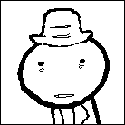|
I thought it might be interesting to try to describe vision to you by analogy with hearing. Both vision and hearing have three primary components: intensity, frequency, and direction. Frequency (colour) isn't actually that important for sight all things considered (at least compared to sound), and the directionality of sight is pretty similar to hearing except that you can only see the 180 degrees in front of you, so I'm going to focus on intensity for simplicity. So, ignoring direction and frequency, the intensity of sounds you hear vs. time could be represented by a cartesian graph with axes of time and intensity, with the sound being a 1-D line. On the other hand, a graph of light intensity seen by a person at a given time would have to be represented by a 2-D surface, with the x and y axes representing position and the z axis representing intensity. A clearer way might be to say that hearing compared to vision is like a speaker compared to a monitor. One creates/recieves a single complicated fluctuation of a value in time (i.e. the movement of the surface of the speaker/eardrum), the other is a 2-D array of many fluctuations (i.e. the individual pixels/rods and cones). This is why people can clearly see every object around them without getting confused, unlike if those objects were all making loud sounds - because thanks to the extra dimensions the values for each object are more sharply separated in the sense space rather than being all lumped on top of each other like sounds can be. Well, I'm not sure if that was much use but at least it was interesting to think about. edit: the other big difference of course is that objects only make sounds under certain circumstances, whereas most things "make images" all the time. ShardPhoenix fucked around with this message at 01:20 on Apr 22, 2007 |
|
|
|

|
| # ¿ Apr 23, 2024 23:03 |
|
Greefus posted:
 is better for more of an "I'm joking" kind of thing. is better for more of an "I'm joking" kind of thing.  is good for "mean" sarcasm and is good for "mean" sarcasm and edit:  is a circle with two eyes and a wedge taken out on the side for a mouth. It's reminiscent of someone with a cheeky grin or similar. is a circle with two eyes and a wedge taken out on the side for a mouth. It's reminiscent of someone with a cheeky grin or similar.  is more like "what an idiot". is more like "what an idiot".edit2: having been blind from birth, do you actually make standard facial expressions given that you haven't seen them yourself? ShardPhoenix fucked around with this message at 21:19 on Apr 24, 2007 |
|
|
|
FreshFeesh posted:An interesting (to me) thought just crossed my mind -- the farther away or fainter a sound is, the harder it is to hear or perhaps identify. Very similarly with sight, the closer one is to ab object, the easier said object can be seen and described. Likewise, some elements are easier than others -- if something is very big (or very loud in the case of sound), it will be easier to discern at a distance. As for the house drawing, the roof part is fine but if the small square to the right is supposed to be the main part of the house then it's too small and in the wrong place. It should be directly under the roof and almost the width of the triangle, with the rectangle of the door being inside the square and about half it's height. Your individual shapes are pretty accurate all things considered though.
|
|
|

